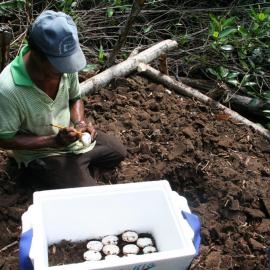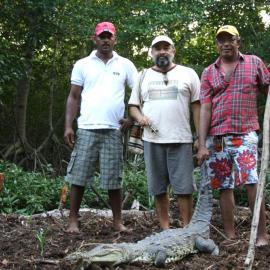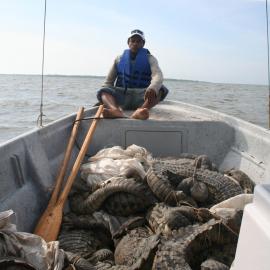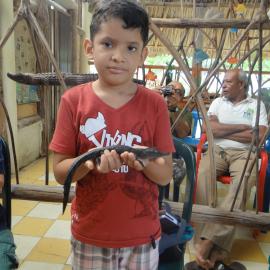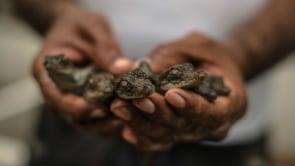Crocodile Conservation in Colombia: ASOCAIMAN
Current initiative
Published
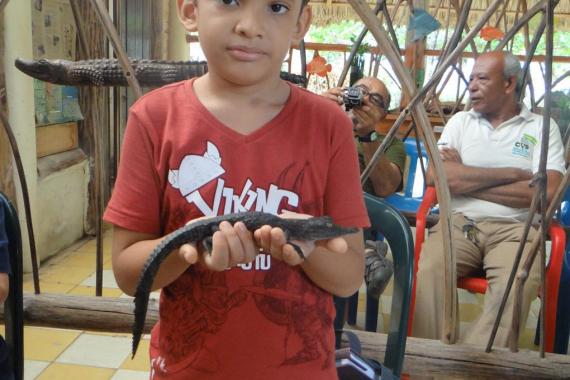
Educating local people about the ASOCAIMAN initiative. Credit: ASOCAIMAN
Livelihoods of the rural communities in the Bay of Cispatá area, Colombia, depend greatly upon natural resources and wild species. This initiative aims to provide options for alternative livelihoods from the sustainable use of the American crocodile as a conservation strategy, which includes stopping poaching.
Location
Bay of Cispatá, San Antero, Córdoba.
Regional District of Integrated Management of the Bay of Cispatá, Colombia State managed protected area; size = 115 km2. GPS coordinates (DMS): 9°24'0" N; 75°49'30" W
Cispatá Bay, north of Lorica, is part of the Department of Córdoba and home to the traditional fishing village of San Antero.
San Antero is a typical village in the Bay of Cispatá, and like most villages in the coastal regions of Colombia, the community is very poor and reliant on the natural resources provided by the mangrove ecosystems for their livelihood, including food, firewood, construction materials, habitat and nursery areas for key species, and natural medicines. Over-exploitation of these resources has not only adversely impacted biodiversity and the environment, but also the quality of life of the people who depend on these resources for their livelihoods.
The poaching and wildlife trade problem
Species affected American Crocodile Crocodylus acutus
Products in tradeThe skin of the American crocodile is highly valued by the luxury clothing and apparel industry.
Locally, farmers, indigenous and afro-Colombian communities are the main users. The meat and eggs are used for food, fat is used for medicinal purposes and teeth and bones are used for ceremonies in witchcraft and shamanism.
Overview of the problem
Across its range, the American crocodile has suffered from intense hunting in response to the demand for its skin and meat.
This includes Colombia, where a prolonged period of heavy trade in skins (that began in 1928) was particularly severe on American crocodile populations. In just four years from 1928 to 1932, somewhere between 700,000 and 800,000 animals were killed to meet the demand for skins: in total around two million animals are thought to have been killed in Colombia during this period.
Consequently, the most conspicuous species in Colombia’s mangrove ecosystems—the American crocodile—was almost completely eliminated from its natural habitat, which was (and continues to be) degraded and destroyed by rampant coastal development, making natural recovery of the species difficult. Populations became restricted to small, isolated pockets of suitable habitat, such as within the mangrove ecosystems in the upper and middle reaches of the Magdalena River and the Bay of Cispatá, which is a protected area that provides ideal habitat for the American crocodile.
In an effort to protect the species, the American crocodile was included in CITES Appendix I (that imposes an international trade ban on all but captive bred species) and the government of Columbia banned hunting of the crocodile.
However, despite these measures illegal trade of live American crocodiles and eggs continued in the Bay, albeit at low levels, reflecting the small, low-density population that remained.
San Antero is a typical village in the Bay, and like all rural villages in the region, local people rely to a large extent upon the natural resources provided by the Bay and its mangrove ecosystems. Over-exploitation and subsequent depletion of the area's natural resources generally, impacted upon the quality of life of local people and put at risk 'societal well-being’, as well as further endangering the American crocodile.
Local farmers, indigenous and afro-Colombian communities are the main users of products provided by the American crocodile. The meat and eggs are used for food, while the remains are discarded, including the skin. Mesenteric fat is used to counteract diseases of the airways. Teeth and bones are used for ceremonies in witchcraft and shamanism.
In terms of the IWT, most poachers are local people, and although though Cispatá Bay is a protected area there was a prevailing culture where wildlife crime was not treated as serious and there has been little law enforcement and protection of crocodiles.
In addition, the IWT—which is secretive and unquantified—has tended to cut the wider community off from the species, creating further problems for its conservation: a once familiar animal that people coexisted with became unfamiliar and something to be feared and not tolerated, stifling possibilities for harmonious coexistence and sustainable use.
The anti-IWT initiative
ASOCAIMAN is a conservation strategy for an endangered species based on meeting (at least in part) the development needs of the local population. The initiative will improve the lives of local people by offering an alternative livelihood and greater capacity to generate income through the legal and sustainable use of the American crocodile.
Two critical goals needed to be achieved before the American crocodile could (at least potentially) legally be harvested and support a sustainable industry:
- Recover the population of American crocodiles in the Bay of Cispatá.
- Have the Bay of Cispatá population moved from Appendix I to Appendix II of CITES (to allow (strictly regulated) international trade in the skins of American crocodiles).
1. In 2003, as part of a wider management plan for the area’s mangrove ecosystems (the Integrated Management Plan of Mangroves), a group of 15 ex-hunters, known as “caimaneros” became active participants in a program for the management of the American crocodile, which included research, monitoring, management and environmental education activities directed towards the recovery and conservation of the species.
In 2006, this community group formed ASOCAIMAN (Asociación para la Conservación de los Caimanes de la Bahía de Cispatá), the legal association under which they can operate, which is supported by the National Research Institute Alexander von Humboltd and in conjunction with the local regional environmental authority and the San Antero Municipality.
ASOCAIMAN seeks to consolidate, build and sustain the crocodile management program.
Support for community development and empowerment lies at the heart of the initiative—it aims to build the capacity of local people to manage and benefit from wildlife. This started with training for the former crocodile hunters so that they could become skilled managers of the crocodile and effective conservationists. The training programme was further developed with help from the National Learning Service which offered ecotourism training based on the conservation project and the site’s mangrove ecosystem.
Surveillance and punishment for inappropriate practices that affect the species and/or its habitat additionally required that the communities were (and continue to be) educated about the importance of the species.
The conservation strategy was based on scientific research, education and ancestral knowledge. Management has been adaptive and in accordance with over 14 years of increasing knowledge and experience. Working closely with Colombia’s environment authority from the outset, the project has developed a standard methodology for crocodile research and management which covers the following: census and monitoring of wildlife populations; habitat management; egg harvesting; artificial incubation and raising and re-release of juveniles into the wild– it does not include wild harvest of larger animals.
A Crocodile Population Management Plan is under development and this will be integrated with the existing mangrove management plan in the Bay of Cispatá. The project has also introduced a process for local and scientific knowledge exchange.
2. Based on the success of the initiative in improving the conservation status of the American crocodile in the Bay of Cispata, on 2nd October 2016 at the 17th CITES convention all parties agreed to move the Cispatá population of crocodiles from CITES Appendix I to Appendix II.
Ultimately, the sustainable use of the American crocodile will generate social, economic, and ecological benefits for local communities through participation in the legal international trade in crocodilian skins and ecotourism. However, as yet this is not fully realised as it is still illegal to hunt the animal in the Bay of Cispatá.
The next step is for the Columbian Ministry of the Environment to lift the ban on hunting animals in the Bay.
The strategy
Increasing incentives for wildlife stewardship
Continued local engagement is largely motivated by the prospects of a legal crocodile industry and the ability to sell a controlled number of skins and meat both locally and internationally.
Based on the success of the initiative in improving the conservation status of the American crocodile in the Bay of Cispatá, on 2nd October 2016 at the 17th CITES convention all parties agreed to move Cispatá population of crocodiles from CITES Appendix I to Appendix II. Thus community members are now able to develop an industry based on the American crocodile. This prospect is a conservation incentive.
The community members receive payment for participating in scientific research and monitoring activities.
Build/and or support sense of community ownership or stewardship
Further detailCommunity knowledge and experience were taken into account as the most important factor every step of the way, which had the effect of building a sense of pride and ownership over the animals and project.
Has the initiative made a difference?
The initiative is having positive results.
1. Recovery of the American crocodile population in the Bay of Cispatá
The conservation and monitoring actions implemented by the local community (ASOCAIMAN) have led to the recovery of the Bay's population of American crocodiles (the abundance of crocodiles has increased steadily and all size classes are represented in natural proportions), and reduced pressures, making it possible to sustainably use and manage the population.
Active management has resulted in an almost 200% increase in the population of the American crocodile in the Bay of Cispatá, and this population has stabilised:
- 9000 crocodiles have been released into the wild.
- The number of animals that could be sustainably harvested each year is currently in the order of 1000-1500 animals (i.e. skins). This is enough to develop a local industry based on legal trade in American crocodile skins (and other parts), whilst contributing to the conservation of this species.
This will eventually contribute to improving the lives of people from local communities by the creation of an alternative, and sustainable livelihood.
2. Poaching and the IWT
The former crocodile hunters are now strong advocates for the conservation and sustainable use of the American crocodile and no longer engage in illegal hunting and as a result, the incidence of poaching has decreased.
3. Community
Through the endeavours of ASOCAIMAN, the economic circumstances of local communities are improving and will be even more once the Colombian government has lifted the ban on hunting this species, which will allow the accomplishment of the ultimate aim of the initiative—a sustainable industry based on the American crocodile.
The 'promise' of a sustainable crocodile skin and meat industry is the key to maintaining the enthusiasm and engagement of local people in the initiative: they understand and appreciate the benefits that will eventually flow their way once the ban on hunting is lifted and they can engage in the sustainable use (harvest) of this species.
In the meantime, ASOCAIMAN is busy establishing the legal framework for the sustainable use industry as well as equipping local people with the skills they will need to effectively participate in the industry.
These former crocodile hunters are now highly skilled in breeding crocodiles and will continue to have a role to play and benefit from their involvement.
This initiative has provided one of the highest levels of stewardship to a crocodilian population in the country. It is owned by local people, has improved their livelihoods, and they are now arguably the most skilled managers of wild crocodilian populations in the country.
The environmental education activities undertaken by ASOCAIMAN has community support and legitimises their presence. Furthermore, the ex-hunters now earn income from their tourist activities, which is centered on the ex-hunters and successes they have had in restoring the crocodile population in the Bay.
4. International policy
At the 17th CITES Convention (October 2, 2016), the project received full support from all parties to allow community members benefit from sustainable harvesting and trade as conservation incentive and agreed to move the Cispatá population of crocodiles from CITES Appendix I to Appendix II.
In addition to the positive impacts mentioned above, the project has improved:
- Social equity
- Environmental sustainability
- The scientific rigour and basis for monitoring crocodiles and has contributed to the body of knowledge of the crocodile and its ecology.
What works and why
The project is working - numbers of American crocodiles in the Bay of Cispasta have risen to the point that the population can be sustainably used.
The initiative's success is due to a number of factors:
- The inclusion of the ex-hunters proved to be critical for the recovery of the population, as no one else had the level of knowledge that they had about the American crocodile and its ecology: their contributions in this regard were invaluable.
If the crocodile poachers of the Bay of Cispatá hadn’t assumed responsibility for recovering the species, it is considered highly likely that this population would not have recovered. The management actions of ASOCAIMAN were based on local knowledge and experience of the American crocodile and its habitat, which was critical for the recovery of the species. Equally, it is highly unlikely that external parties (e.g. rangers, policy officers, environmental authorities) would have been able to include this knowledge in the design of the species management strategy or be able to acquire this essential knowledge in time to save this population from extinction.
- It is owned by local people (the ex-hunters), and it has improved their lives (alternative and legal means of earning an income, and generation of skills). They are now arguably the most skilled managers of wild crocodilian populations in the country, with experience in monitoring, boosting local C. acutus reproduction by building additional nesting platforms, egg collection, incubation, hatchling raising, restocking the local wild population, and protecting the animals from outside interference.
- The environmental education activities undertaken by ASOCAIMAN has generated community support and legitimates their presence.
- The sustained enthusiasm of the local people for the conservation project over a number of years is based on the knowledge that communities will be able to benefit from sustainable use in the context of a management plan.
Factors for success
Supportive national policy/legislation for devolved governance of natural resources
Coordinated and coherent sectoral policies/legislation (For example, land use planning, agricultural etc...)
Supportive, multi-stakeholder partnerships with a shared vision
Sufficient time investment in building relationships and trust between the initiative and local communities
Clear and tangible benefits to local communities from wildlife (These may be financial and/or non-financial)
18 uninterrupted years of work together between researchers and the local community on the frame of the integral mangrove management plan of the Bay of Cispata sustainable zone.
ASOCAIMAN is a community association made up of former crocodile ex-hunters and they make all the internal decisions.
The skin of Crocodylus acutus is an extremely desirable product in the global leather trade and market. If managed sustainably, local communities have an opportunity to develop an industry based on the legal (international) sale of crocodile skins. The generation of additional income and jobs will help to improve livelihoods and raise these communities out of poverty.
Ecotourism is emerging as the second most important activity and is based on the activities and involvement of ASOCAIMAN (former poachers) in the management and conservation of the American crocodile and mangrove ecosystems in the Bay of Cispata.
Environmental education, mangrove gardening, handicrafts, bee-keeping and the farming of other wildlife species complement the range of activities and production projections for the immediate future. These are currently being developed experimentally with input from the communities (Nb. this is currently lacking the required support).
What doesn’t work and why
The low technical capacity of national and local environmental authorities to undertake practical management actions to restore crocodile population, as well as their poor ability and reluctance to recognise and validate the knowledge of communities and their capacity to engage.
Factors that limited or hindered success
Lack of supportive national policy/legislation for devolved governance of natural resources
The low technical capacity of national and local environmental authorities to undertake practical management actions to restore crocodile population, as well as their poor ability and reluctance to recognise and validate the knowledge of communities and their capacity to engage.
The Ministry of Environment hasn't lifted the hunting ban to exclude the C. acutus population at Cispata Bay, primarily because its low capacity to engage with the regional authority.
Organisers, donors and partners
Environmetal Ministry, Regional Enviromental Authoriy - CVS, San Antero Municipality, Alexander von Humboltd Institute, Sinchi, ICN-UN, Andes University, SENA, Agriculture Ministry, Educational Ministry. Crocodile skins Industry: Exótica-Leather y Crocol S.A, Natura Fundation, Agrosoledad. Media: Natural Press, El Espectador, El Tiempo, Caracol, Gaviero Films. OIMT, CITES, OEA, CSG-IUCN.
For further information contact Clara Lucia Sierra Diaz (clsierra@hotmail.com).

